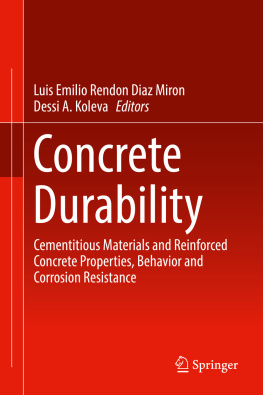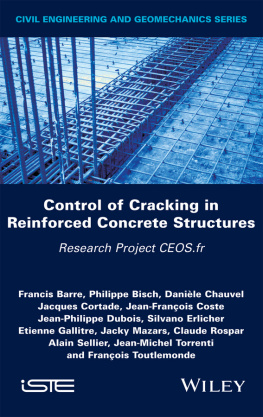Properties of concrete
Fifth Edition
A. M. Neville
CBE, DSc(Eng), DSc, FIStructE, FREng, FRSE
Honorary Member of the American Concrete Institute
Honorary Member and Gold Medallist of the Concrete Society
Honorary Member of the Brazilian Concrete Institute
formerly
Head of Department of Civil Engineering, University of Leeds, England
Dean of Engineering, University of Calgary, Canada
Principal and Vice-Chancellor, University of Dundee, Scotland
President of the Concrete Society
Vice-President of the Royal Academy of Engineering

Harlow, England London New York Boston San Francisco Toronto Sydney Singapore Hong Kong
Tokyo Seoul Taipei New Delhi Cape Town Madrid Mexico City Amsterdam Munich Paris Milan
Pearson Education Limited
Edinburgh Gate
Harlow
Essex CM20 2JE
England
and Associated Companies throughout the world
Visit us on the World Wide Web at:
http://www.pearsoned.co.uk
A M Neville 1963, 1973, 1975, 1977, 1981, 1995, 2011
The rights of A M Neville to be identified as the author of this work has keen asserted by him in accordance with the Copyright, Designs, and Patents Act 1988.
All rights reserved; no part of this publication may be reproduced, stored in any retrieval system, or transmitted in any form or by any means, electronic, mechanical, photocopying, recording or otherwise without either the prior written permission of the Publishers or a licence permitting restricted copying in the United Kingdom issued by the Copyright Licensing Agency Ltd, 90 Tottenham Court Road. London WIT 4LP
First published 2011
ISBN: 978-0-273-75580-7
British Library Cataloguing in Publication Data
A catalogue entry for this title is available from the British Library.
Library of Congress Cataloging-in-Publication Data
Neville, Adam M.
Properties of concrete / A.M. Neville. -- 5th ed.
p. cm.
ISBN 978-0-273-75580-7 (pbk.)
1. Concrete. I. Title.
TA439.N48 2011
620.136--dc23
2011019819
Set by 35 in 10/12 Monotype Times
Printed in Malaysia (CTP-VVP)
5 4 3 2 1
15 14 13 12 11
Contents
Preface to the Fifth Edition
The format, organization and style of this edition are the same as those of the previous editions. The justification is that those features have shown themselves to be successful by the fact that sales have continued to be strong right up to the year 2011. The total sales in English, as well as in the 12 languages into which this book has been translated, exceed half-a-million copies over a period of nearly half-a-century.
With the passage of time, standards evolve, become modified, withdrawn and replaced. This produces a need for updating a technical book such as Properties of Concrete and can be accommodated by minor changes in new impressions of an existing edition, as was done in the 14 impressions of the fourth edition, which I intended to be final. This is still the case with American standards, where ASTM has a strict policy of periodic reviews, confirmation or replacement.
On the other hand, the situation of the British standards is far more complex. Specifically, there exist now some new British standards, described as also European standards, denoted by BS EN. There continue to be in force some traditional British standards, denoted by BS. In some cases, the British standards are described as obsolete, obsolescent, and also as current, superseded. All this is highly confusing but is perhaps an inevitable consequence of a piecemeal introduction of new standards, which do not simply replace the old ones on a one-to-one basis. There is a well-known saying that a camel is a horse designed by a committee. The European standards are designed by an international committee!
I have retained by way of tables and limits information contained in a number of the old British standards, even those that have been withdrawn, because they contribute to knowledge of what is desirable in the understanding of a relevant property. I believe that such an approach is valuable in a scientific book, encyclopaedic in character. This is especially so because a number of the new BS EN standards lay down how to measure some property of concrete and then to declare the outcome but say nothing about the interpretation of the result. Such an approach does not contribute to knowledge of what is desirable, let alone to understanding of the relevant property.
The new standards have been introduced in this fifth edition of Properties of Concrete for the purpose of informing the reader about the approach to, or principles of, testing. However, given continuing evolution of standards, for specific use, the reader should refer to the text of the actual standards and follow them scrupulously. After all, this book is not intended to be a manual or handbook, let alone a cookbook.
Furthermore, I have not deleted references to earlier publications. I did so for two reasons. Firstly, this is a new edition of a successful book and not a new book. Secondly, the old references contain the development of our knowledge, much of it basic. On the other hand, many of the recent papers contain minutiae of specific behaviour under specific conditions, and contribute but little to the pool of knowledge capable of generalization.
It may be a reflection of my age but I find that our pool of knowledge of value to designers, contractors and suppliers is not greatly increased by a paper co-authored by six people without much coordination or generalization. Nor are papers describing the behaviour of concrete incorporating fly ash from a single source of value to the concrete community at large, the main benefit being commercial or personal.
This edition contains some additional topics: delayed ettringite formation, recycled concrete aggregate, self-compacting concrete, thaumasite sulfate attack, and of course augmentation and modification of various topics.
I have not included that topical subject, sustainability (which seems to be the flavour of the decade). As I see it, if sustainability of concrete as a material (distinct from a structure made of concrete) is to ensure durability, then of course, this is of great importance; for this reason are devoted to the durability of concrete.
However, durability does not mean a service life as long as possible. What we should aim at is a desired service life, and this is governed by the function of the structure: a garden shed is at the lower end of the scale, and a large bridge or dam are at the upper end. Dwellings are a good example of social needs changing with time, e.g. lifts (elevators) or bathrooms. Likewise, offices may be of the open plan type or they may consist of numerous separate rooms Where there is a social usage change, the old style may be a disadvantage in that a modification of the structure may be more expensive than demolition followed by a new design. And paying in advance for a more expensive structure in the first place is uneconomical and may also discourage construction. But these issues are outside the scope of this book. So, if I do not enthuse over sustainability, it is not because of my ignorance.
In writing the fifth edition, and especially in including references to new standards, I have been greatly assisted by Robert Thomas, Manager, Library and Information Services of the Institution of Structural Engineers and by Rose Marney, Library Manager and Debra Francis, Librarian, of the Institution of Civil Engineers. Their exceptionally efficient and friendly help is gratefully acknowledged.
I am grateful to Simon Lake for progressing the contractual aspects of the fifth edition and to Patrick Bond, Robert Sykes and Helen Leech for looking after the production aspects of the book.










